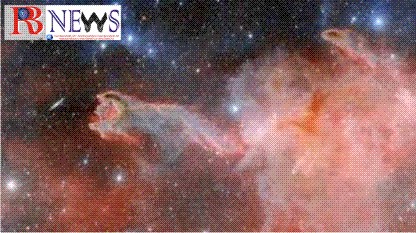The Dark Energy Camera has captured an amazing image, which may even surprise you. This photo shows a ghostly hand stretching towards a distant spiral galaxy in the universe. This hand has been named “Hand of God”. In this picture, celestial structures, clouds of gas and dust are visible. DECam, installed on the Victor M. Blanco Telescope in Chile, has captured this rare phenomenon, known as a cometary globule, providing a glimpse into the depths of our universe.
What are humoral globules?
Comet globules, which were first observed in 1976, are unrelated to comets. These are dense, dense clouds of gas and dust in space that are shaped like comets with long, faintly glowing tails. Their cores usually contain newborn stars and are produced by heavy radiation from nearby stars. Comet globules play a major role in the process of stellar birth and evolution within galaxies. In the picture, it looks like the ‘hand of God’ is about to grab ESO 257-19 (PGC 21338), but in reality, the distance between them is about 100 million light years.
What is this hand of God?
Images of “God’s Hand” that have emerged show CG4, a cometary globule found within the Milky Way galaxy in the constellation ‘Puppis’, 1,300 light years away. CG4 has a prominent dusty head, resembling a rotating hand, which is 1.5 light years across, while a long tail extends up to 8 light years. (A light year is the distance that light travels in one year, equal to approximately 9.46 trillion kilometers).
The “hand of God” appears to be reaching out toward a distant spiral galaxy called ESO 257-19 (PGC 21338) 100 million light years away. Although its name means “Hand of God”, there is nothing supernatural about the celestial structure. The breathtaking image of CG4 was taken by DECam (Dark Energy Camera), a high-tech instrument on the Victor M. Blanco Telescope in Chile, 7,200 feet above sea level.
Cometary globules were accidentally spotted by astronomers while studying images from the UK Schmidt Telescope in 1976. These structures are difficult to identify because they are very faint and their tails are often covered with stellar dust. But DECam has a special filter that can catch the faint red glow from ionized hydrogen, which is present in the outer rim and head of CG 4. Although this radiation makes the humoral globule visible, over time it destroys its head. However, there is still enough material inside to form new stars like our Sun, and that’s amazing.
 RB News World Latest News
RB News World Latest News






